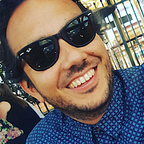Abstract: This entry shows the mistakes that I made when the picture was taken and the different adjustments that I did to it afterwards.
The idea that I have with this is to keep a record of my photos over a period of time, to track if there has been any progress. Also, I would like to share my point of view about photography, hoping that at some point it could be useful to someone else.
This entry is based solely on the way I think about photography: As an amateur with lots of things to learn.
Context:
This photo was taken in one of the temples of Angkor in Cambodia. It was just a few days before the end of the Khmer year. A woman was collecting money besides a Buddha statue, in exchange she would give you a bracelet made of sewing threads that will bring you luck during the upcoming year. I gave her money and ask her if I could take a picture. I guess she thought I wanted a picture of Buddha, because she looked very surprised when I said I actually wanted a picture of her. So she had the mood, was happy and ready to pose.
The picture:
I made several mistakes when taking this picture, including the two that can not be corrected on post processing: Composition and focus problems. The other problem that I found, bad exposure, can be fixed in most cases.
— Focus: I had a single point focus area with focus lock set up on the camera. As the book says, I tried to put the focus point on her eyes.
You don’t need to look the picture a lot to notice that her face is not sharp. Her eyes in particular, are either not focused or blurred (I have to say that the light wasn't helping a lot). That is, in my opinion, the biggest problem of this photo.
Leaving all of the theory behind, I know that the easiest way to prevent this is to check the photo in the camera. Zoom to the eye the more you can and verify they are focused and sharp. If they are not, repeat the picture, take many. I actually don’t know what happened this time, but I only took ONE! Only ONE picture of that unique moment and I didn't check the viewer of my camera after that.
Another thing that I would try, and this is based on nothing else than on my curiosity, is to change the focus settings radically. Focus lock is good if you are sure that neither you or the subject will move. However, if you use short focal lengths, the smallest movement will get your picture out of focus. Maybe next time I would try a continuous focus (AF-A in Nikon), and more than one focus point, so the AF system can have more information and choose better what to focus. I will post the result of this as a comment of this entry.
— Composition: Here comes the other big problem of this picture. I wanted the typical picture of the subject besides his working place and tools. In this case, I wanted to show somehow what she was doing: Decorating the altar, collecting money, making the bracelets, praying to Buddha.
Nothing of that was captured in the picture.
Furthermore, the right arm of the lady is cut, this gives me the feeling of a forced framing. She is just too close to the edge of the photo.
Of course, I wasn't planning this and I didn't have all the time to decide what sort of composition did I want. However, having taken only ONE picture didn't give me much of a choice.
So again, next time I face a situation like this, I will just take heaps of shots, with different focal lengths and different framing. That will, at least, give me more options to choose when I decide what sort of composition do I want.
Besides all of the theory you can find about composition, I believe that it is here where creativity plays the most important role.
Post processing:
The main adjustments were made to the monk and to Buddha.
I wanted her face to look more dramatic, so I increased the contrast on it as well as the clarity. Since the face was out of focus, I put rather big numbers on those two fixes.
I have also increased the exposure and saturation on the statue to give it a bigger presence on the picture (according to the subject and the tools kind of composition that I wanted).
The rest, just minor adjustments to the exposure of the background and spot removals.
Any comments, of course, are more than welcome!
